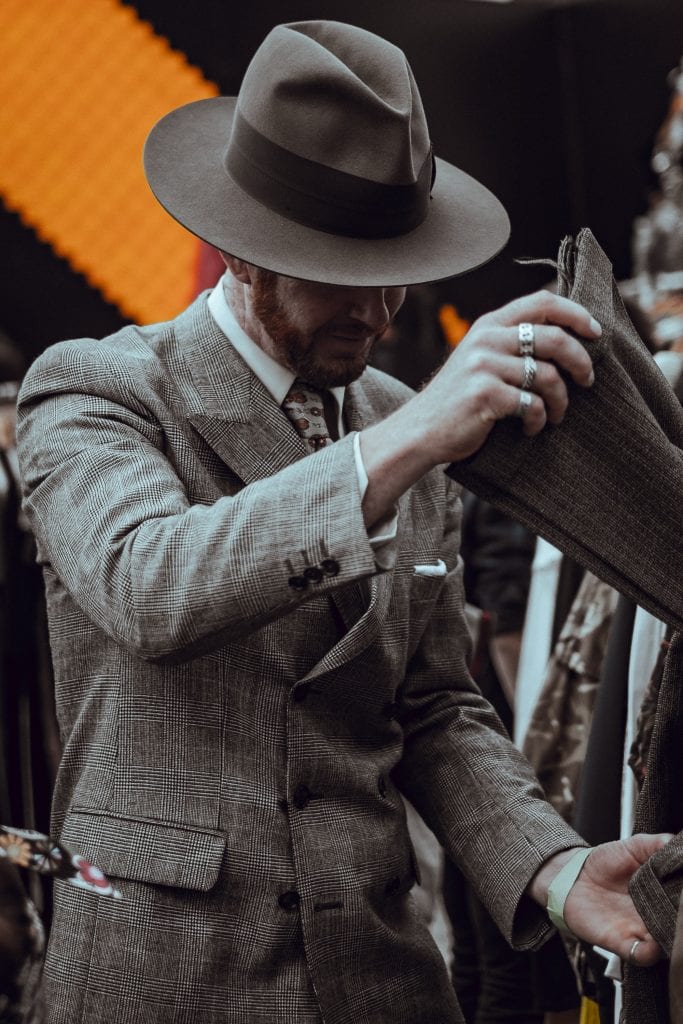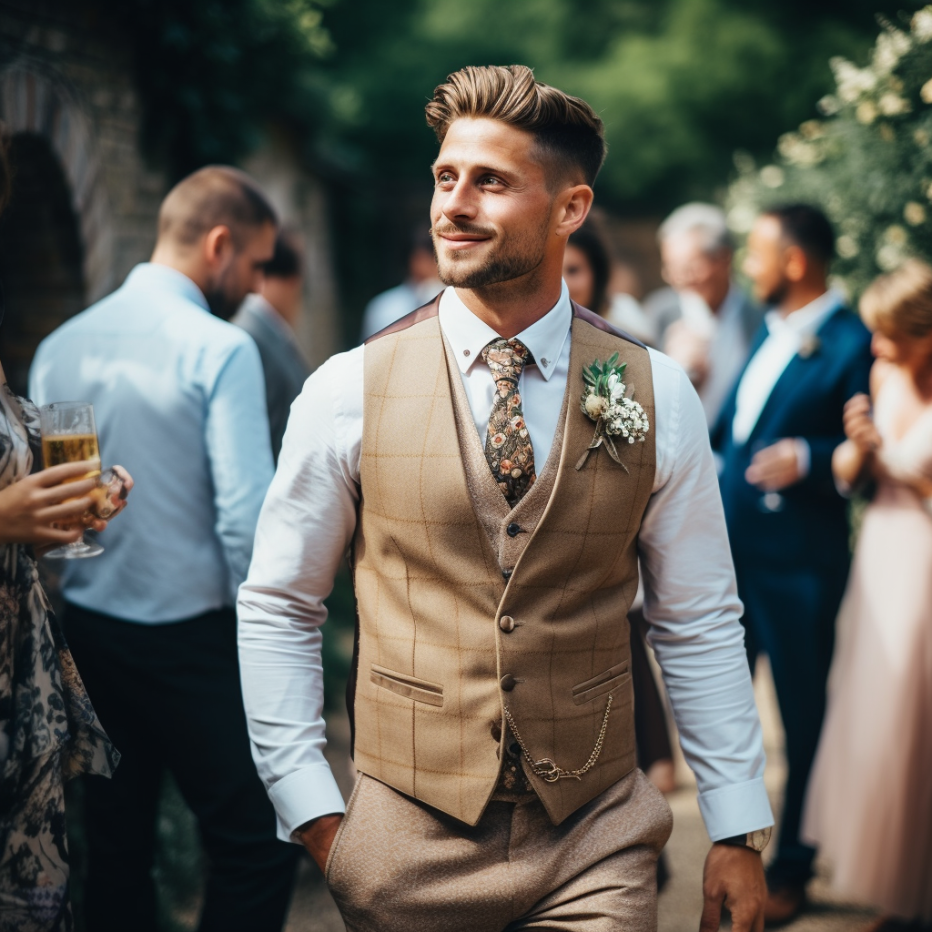Here, we aim to provide a comprehensive guide to help you discern the subtle and not-so-subtle differences in men’s suit styles.
When it comes to sartorial elegance, few garments make as significant an impression as a well-tailored men’s suit. The legacy of the suit is long and storied, intricately woven into the fabric of history and culture. Over the years, the suit has evolved, embracing various styles and configurations.
Yet, one truth remains irrevocable—the style of a man’s suit speaks volumes, not only about personal taste but also understanding of occasion, context, and etiquette. It serves as an unspoken language that weaves character, professionalism, and gravitas into a unified aesthetic expression. This is why understanding men’s suit styles is so critical.
The Anatomy of a Suit
To fully grasp the nuances of men’s suit styles, one must first understand its basic anatomy. A suit isn’t merely a jacket and trousers sewn from the same fabric. Each component—jacket, trousers, and sometimes a waistcoat—has stylistic choices that can drastically alter the ensemble’s overall look and feel.
1. The Jacket
Single-breasted vs. Double-breasted
The first point of distinction often comes between single-breasted and double-breasted jackets. The former is arguably the most common, offering a clean, modern suit style suitable for most occasions. The latter features overlapping fabric and two columns of buttons, lending itself to a more formal, British suit style.
Single Vent vs. Double Vent vs. No Vent
The vent—the slit at the back of the jacket—also plays a critical role in the garment’s overall aesthetics and functionality. A single vent is typically seen in American suit styles and offers ease of movement. Double vents, a hallmark of British tailoring, allow for even greater flexibility and lay cleaner when you sit. The absence of a vent leans towards an Italian suit style, prioritising sleek lines but limiting mobility.
Lapels: Notch, Peak, Shawl
Lapels can subtly influence the style and formality of a suit. Notch lapels are versatile and common, apt for business settings. Peak lapels add a touch of flair and are often found on double-breasted jackets, resonating with a British suit style. Shawl lapels, generally reserved for tuxedos, offer a more elegant, formal look.
2. The Trousers
Pleats vs. Flat-Front
When it comes to trousers, pleats offer a classic, British touch and a bit more room for comfort, whereas flat-front pants offer a more modern suit style, popular in Italian and American designs.
Breaks
The ‘break’ refers to the fabric fold at the bottom of the trousers where they meet your shoes. A full break is traditional, but a half or no break offers a more modern, tailored aesthetic.
3. The Waistcoat (Optional)
Single-breasted vs. Double-breasted
Similar to jackets, waistcoats come in single and double-breasted styles. Single-breasted is more versatile, while double-breasted adds an extra layer of formality.
Backless vs. Full-back
A backless waistcoat is a clothing item that is commonly worn at formal events. It typically comes with adjustable straps to ensure a comfortable fit. A full-back waistcoat offers a more polished look, suitable for instances where you might remove your jacket.
4. Accessories
Tie, Pocket Square, Cufflinks
The devil is in the details. A well-chosen tie, pocket square, and set of cufflinks can elevate your suit from mere clothing to a full ensemble. These items allow for personal expression within the context of formalwear.
Types of Men’s Suit Styles
1. The Slim-Fit Suit
Characterised by narrow lapels and a slender silhouette, the slim-fit suit is the epitome of modern suit style. This style is ideal for those with a lean physique and is appropriate for creative businesses and less formal occasions.
2. The Classic Fit Suit
Offering more room for comfort, the classic fit suit is evergreen and can easily adapt from boardrooms to weddings. This style is an excellent representation of timeless British-suit craftsmanship.
3. the Two-Piece Suit
The most common of all, comprising a jacket and trousers. It’s versatile and can adapt to a casual suit style, particularly when you choose lighter fabrics or playful patterns.
4. The Three-Piece Suit
Adding a waistcoat to a two-piece ensemble makes a three-piece suit, elevating the level of formality and adding a layer of stylistic complexity.
5. The Tuxedo
Reserved for the most formal of occasions, tuxedos often feature satin lapels and side stripes on the trousers. Shawl lapels are common, making them a unique entity in the realm of men’s suit styles.
Choosing the Right Fabric
1. Wool: Types and Seasons
Wool is the most traditional and versatile fabric, suitable for most seasons depending on the weave and weight.
2. Linen: Ideal for Summer
Linen suits offer a casual suit style, ideal for summer events but prone to wrinkles.
3. Cotton: Versatile and Casual
A cotton suit works well for a relaxed, casual appearance and is versatile enough for various settings.
4. Velvet and Silk: Special Occasions
These fabrics are luxurious and suited for special occasions. Velvet leans towards a winter setting, while silk is more season-neutral but decidedly opulent.
Understanding men’s suit styles is an art that requires attention to detail and an appreciation for craftsmanship. Whether you lean towards a British, American, or Italian suit style or perhaps something that combines elements of each, the key is choosing the style that resonates with your aesthetic and the occasion at hand.
Experience the Pinnacle of Tailoring with the Hidalgo Brothers
You’ve taken the first steps in understanding the intricate world of men’s suit styles, but nothing compares to the bespoke experience. At Hidalgo Brothers, we don’t just craft suits; we build legacies. With our roots deep in the rich tradition of Savile Row tailoring, we offer an unparalleled mastery over British and international styles, incorporating classic craftsmanship with modern flair. Get in touch with us for more information.
Common Questions
1. How do British, American, and Italian suit styles differ?
British suit styles are known for their structured form and attention to detail, often featuring double-breasted jackets, peak lapels, and double vents. American suit styles are more relaxed, often with single-breasted jackets and a single vent. Italian suit styles focus on a sleek, slim silhouette with softer shoulders, often featuring no vent and notch lapels. At Hidalgo Brothers, we offer the best of all worlds, expertly crafting suits that can incorporate elements from British, American, and Italian designs based on your personal preferences.
2. How long does it take to craft a bespoke suit at Hidalgo Brothers?
The process generally takes about 6-8 weeks from your first consultation to the final fitting. This allows time for multiple fittings and any necessary adjustments, ensuring that your suit is nothing short of perfect. Our commitment to excellence means we won’t rush the process; quality takes time, and it is the hallmark of a Hidalgo Brothers bespoke suit.
3. Can I choose the fabric and accessories for my bespoke suit at Hidalgo Brothers?
Choosing your fabric and accessories is an integral part of the bespoke experience at Hidalgo Brothers. During your consultation, you can peruse an extensive selection of premium fabrics, ranging from classic wools to luxurious silks and velvets. Our experts will guide you through the qualities of each, helping you make an informed choice based on your needs and the occasions for which the suit is intended. Additionally, we offer a wide range of accessories, including ties, pocket squares, and cufflinks to perfectly complement your bespoke suit.


